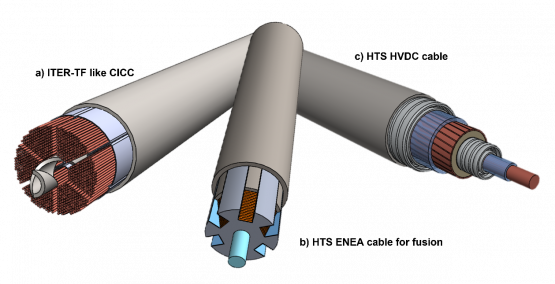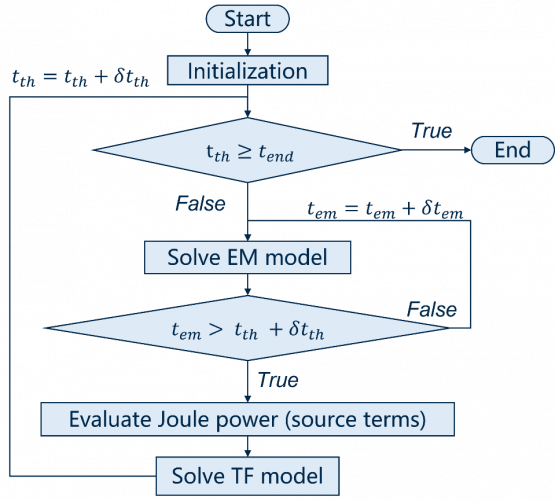OPENSC2: an open-source object-oriented model for superconducting cables
Main activity within Daniele Placido’s PhD (tutored by Prof Laura Savoldi and Prof. Alessandro Savino) in the framework of the numerical modeling of superconductors for fusion and power transport applications, in collaboration with Prof. Fabio Freschi.
Object of the activity
Development of an open-source object-oriented software (OpenSc2) that easily manages different cables designs, configurations and coolants at the mesoscale level (see Figure 1.), suited for both low and high temperature superconducting materials (LTS - HTS), equipped with a user-friendly graphic user interface.

Figure 1. Different cable configurations which can be model by OpenSc2: a) low temperate superconductor for fusion ITER-TF like cable-in-conduit (CICC); b) high temperature superconductor for fusion (ENEA design); c) single-core high temperature superconductor for power transmission at high voltage in direct current (HVDC).
Framework of the activity
Within the framework of a carbon-free economy, superconducting cables (SC) and magnets in the past decades have enabled fundamental discoveries for the high-energy physics and amazing steps forward in the research on a clean energy. Different kinds of SC cables are available, according to the applications, based on different SC materials and different concept for their cooling (conduction-cooling, coolant bath of forced-flow): in particular, we focus on nuclear fusion and power transmission fields.
In the field of fusion cables, several numerical tools are well established for the analysis of the transients in LTS cables, and namely the 4C code [1], the THEA/SUPERMAGNET Suite [2], and the VINCENTA/VENICIA suite [3], whose main features are reported in Table 1.
Table 1. Comparison of the main features of 4C, THEA/SUPERMAGNET and VINCENTA/VENICIA codes.
| Feature |
THEA/SUPERMAGNET |
VINCENTA/VENICIA |
4C |
| Use |
Commercial license |
Commercial license |
Proprietary |
| Geometry |
Arbitrary |
Wide range of cases |
CICCs with ≤3 channels; some HTS cables (H4C) |
| Fluids |
Multi-fluids |
He, N2, O2, Ne, H2O |
SHe |
| LTS |
Y |
Y |
Y |
| HTS |
Y |
Y |
Y (H4C) |
| Spatial discretization |
FEM |
3rd order FDM |
1st order FEM |
| Time integration scheme |
3rd order adaptive multi-step |
Semi-explicit splitting-up |
Adaptive BE or CN |
| Pre and post-processing |
Separate pre-, inner post-processor |
Inner pre- and post-processor |
Performed with external tools |
| GUI |
Y |
Y |
N |
| Validation |
++ |
+ |
+++ |
As regards power transmission cables, numerous ad hoc models [4]–[6] have been developed to solve specific problems, most of them in stationary condition, using commercial software or developing home-made algorithms. At the best of our knowledge, a robust comprehensive model in terms of thermal-hydraulic and electrical transient models is still missing in literature.
Adhering to the philosophy of open science, a priority according to the European Commission (Horizon Europe), the OpenSc2 is an open-source alternative software granting the entire research community the possibility to simulate transient behavior of LTS and HTS, for both fields above mentioned. Through Object-Oriented Programming (OOP), the software is featured by a high flexibility in modeling different cables topologies, guaranteed using Python as programming language.
Thermal-hydraulic and electromagnetic coupling
The thermal-hydraulic transient model has been implemented and validated against 4C code: it accounts for different refrigerant fluid paths, with the possibility to accounts for different coolants that could be present at the same time in different regions of the cable.
The electromagnetic model for current-carrying elements of cables describes the current distribution accounting for the transient losses whenever present and the interaction between the different strands or tapes, according to the cable layout. The equivalent circuit is based on electrical resistances and impedances along the current carrier axes and electric conductances between current carriers.
The coupling between the thermal-hydraulic and electromagnetic model is ongoing, whose flow-chart is shown in Figure 2.

Figure 2. Flow chart of the thermal-hydraulic and electromagnetic models coupling.
Thermal-hydraulic and electromagnetic modeling of non-planar coils based on VIPER cables concept
In OpenSc2, the possibility to model a winding pack as several conductor objects in thermal and electric contact is a straightforward step in the development. At the time being, an arbitrary number of adiabatic and electrically insulated conductors of possibly different configurations can be simulated at the same time. Since heat diffusion between adjacent conductors takes place on a time scale that is larger compared to the one in which heat diffuses within a single conductor, this coupling can be done according to an explicit and weak model.
The purpose of this activity is to model the quench of non-planar coils based on VIPER-like cables [7] and extend OpenSc2 to a multi-turn, multi-pancake coil. A rendering of the VIPER cable and of the stellarator, a fusion machine that exploits non-planar coils for plasma confinement are shown in Figure 3. The model will be calibrated and validated against experimental measurements carried out at the Swiss SULTAN test facility in 2019 for quench detection purposes [8]; moreover, a code-to-code validation against COMSOL models will be carried out. A test-driven development approach will be adopted to develop and validate OpenSc2 in the framework of a multi-turn, multi-pancake non-planar coil. The possibility of using OpenSc2 to model the quench behavior of a full-scale Stellarator coil will also be explored.
Thermal-hydraulic sensitivity analysis (mass of helium flow, sensitivity to temperature change, hot helium waves, etc) will be carried out together with the verification of first and second principles of thermodynamics.
The final product of this activity will be a general and flexible tool that will also be able to model, as a special case, all configurations in which the magnets are actually planar, such as tokamaks

Figure 3. a) planar 3D VIPER cable design; b) non-planar coils in a stellarator fusion device.
References:
[1] L. Savoldi Richard, F. Casella, B. Fiori, and R. Zanino, “The 4C code for the cryogenic circuit conductor and coil modeling in ITER,” Cryogenics, vol. 50, no. 3, pp. 167–176, Mar. 2010, doi: 10.1016/j.cryogenics.2009.07.008.
[2] M. Bagnasco, D. Bessette, L. Bottura, C. Marinucci, and C. Rosso, “Progress in the Integrated Simulation of Thermal-Hydraulic Operation of the ITER Magnet System,” IEEE Trans. Appl. Supercond., vol. 20, no. 3, pp. 411–414, Jun. 2010, doi: 10.1109/TASC.2010.2043836.
[3] D. Bessette, N. Shatil, and E. Zapretilina, “Simulations of the ITER Toroidal Field Coil Operation With the VINCENTA Code,” IEEE Trans. Appl. Supercond., vol. 16, no. 2, pp. 795–798, Jun. 2006, doi: 10.1109/TASC.2006.873258.
[4] W. T. B. de Sousa, D. Kottonau, J. Bock, and M. Noe, “Investigation of a Concentric Three-Phase HTS Cable Connected to an SFCL Device,” IEEE Trans. Appl. Supercond., vol. 28, no. 4, pp. 1–5, Jun. 2018, doi: 10.1109/TASC.2018.2794586.
[5] S.-J. Lee, H.-J. Sung, M. Park, D. Won, J. Yoo, and H. S. Yang, “Analysis of the Temperature Characteristics of Three-Phase Coaxial Superconducting Power Cable according to a Liquid Nitrogen Circulation Method for Real-Grid Application in Korea,” Energies, vol. 12, no. 9, p. 1740, May 2019, doi: 10.3390/en12091740.
[6] C. L. Buiar and J. V. C. Vargas, “Thermodynamic analysis applied to superconducting DC cable model,” p. 8, 2012.
[7] K. S. Haran et al., “High power density superconducting rotating machines—development status and technology roadmap,” Supercond. Sci. Technol., vol. 30, no. 12, p. 123002, Dec. 2017, doi: 10.1088/1361-6668/aa833e.
[8] Z. S. Hartwig et al., “VIPER: an industrially scalable high-current high-temperature superconductor cable,” Supercond. Sci. Technol., vol. 33, no. 11, p. 11LT01, Nov. 2020, doi: 10.1088/1361-6668/abb8c0.

